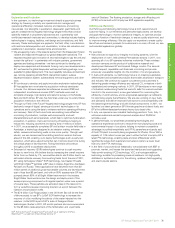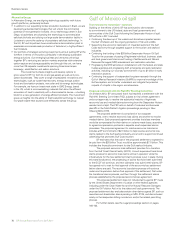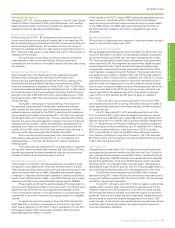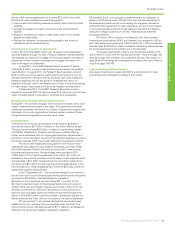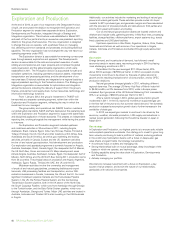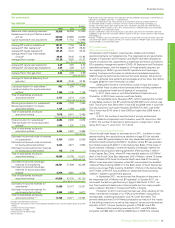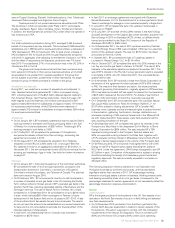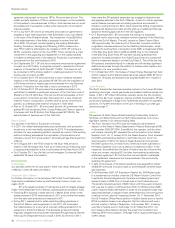BP 2011 Annual Report Download - page 76
Download and view the complete annual report
Please find page 76 of the 2011 BP annual report below. You can navigate through the pages in the report by either clicking on the pages listed below, or by using the keyword search tool below to find specific information within the annual report.
74 BP Annual Report and Form 20-F 2011
Business review
performance on a quarterly basis. They agree strategic direction and group
standards which are then implemented through business specific diversity
and inclusion plans. We supported the UK government-commissioned
Lord Davies review in 2011, which made recommendations on increasing
gender diversity on the boards of listed companies.
We are also incorporating detailed diversity and inclusion analysis
into talent reviews, with processes to identify actions where any issues are
found. We continue to increase the number of local leaders and employees
in our operations so that they reflect the communities in which we operate.
By 2020, more than half our operations are expected to be in
non-OECD countries and we see this as an opportunity to develop a new
generation of experts and skilled employees. At the end of 2011, 15% of
our group leaders were female and 19% came from countries other than
the UK and the US. When we started tracking the composition of our group
leadership in 2000, these percentages were 9% and 14% respectively. BP
has increased the percentage of female leaders in 2011 and remains focused
on building a more sustainable pipeline of diverse talent for the future.
We aim to ensure equal opportunity in recruitment, career
development, promotion, training and reward for all employees, including
those with disabilities. Where existing employees become disabled, our
policy is to provide continuing employment and training wherever practicable.
Employee engagement
Executive team members hold regular town halls and webcasts to
communicate with our employees around the world.
Team meetings and one-to-one meetings are the core of our
employee engagement, complemented by formal processes through
works councils in parts of Europe. These communications, along with
training programmes, are designed to contribute to employee development
and motivation by raising awareness of financial, economic, ethical, social
and environmental factors affecting our performance. The group seeks to
maintain constructive relationships with labour unions.
We conduct an employee engagement survey to monitor employee
attitudes and identify areas for improvement. Our 2010 employee survey
was delayed to allow for organizational changes to be reflected in the
survey construction. This was completed and we carried out an employee
engagement survey in 2011. The 2011 survey found that employees are
committed and understand BP procedures and standards. The results
show that there are a number of areas that can be improved. These include
increasing transparency of the promotion process and being clear about the
organization’s priorities. Business leadership teams reviewed the results of
the survey and have agreed actions to address the identified issues.
The survey includes 10 questions which make up the employee
satisfaction index. The overall employee satisfaction index score for 2011
(62%) was below the score from 2009 (65%) but above that of 2008 (59%).
The code of conduct
The BP code of conduct sets the standard that all BP employees are
required to work to. It is aligned with our values, group standards and legal
requirements, and it clarifies the ethics and compliance expectations for
everyone who works at BP. The code was updated in 2011 and now puts
greater emphasis on a values-based approach.
The code defines what BP expects of its people in key areas such as
safety, workplace behaviour, bribery and corruption and financial integrity.
Employees, contractors or other third parties who have questions or
concerns that laws, regulations or the code of conduct may be breached,
can get help through OpenTalk, an independent confidential helpline. The
number of cases raised through OpenTalk in 2011 was 796, compared
with 742 in 2010. In the US, former district court Judge Stanley Sporkin
acts as an ombudsperson. Employees and contractors can contact him
confidentially to report any suspected breach of compliance, ethics or the
code of conduct, including safety concerns.
We take steps to identify and correct areas of non-compliance and
take disciplinary action where appropriate. In 2011, 529 dismissals were
reported by BP’s businesses for non-adherence to the code of conduct or
unethical behaviour compared to 552 in 2010.
BP continues to apply a policy that the group will not participate
directly in party political activity or make any political contributions, whether
in cash or in kind. We review employees’ rights to political activity in each
country where we operate. For example, in the US, BP facilitates staff
participation in the political process by providing staff support to ensure BP
employee political action committee contributions are publicly disclosed
and comply with the law.
Technology
Technology in BP
We define technology in BP as the practical application of science to
manage risks, capture business value and inform strategy development.
This includes the research, development, demonstration and acquisition of
new technical capabilities and support for the deployment of BP’s know-
how.
BP’s model continues to be one of selective technology leadership,
under which we focus on major technology programmes that best support
our business priorities and competitive performance.
External assurance is achieved through the technology advisory
council, which advises the board and executive management on the state
of technology within BP. The council is comprised of eminent business and
academic technology leaders.
In 2011 we invested $636 million (of which $12 million related
to the response to the Deepwater Horizon incident) in research and
development (R&D). This compares with $780 million in 2010 (of which
$211 million related to the response to the Deepwater Horizon incident),
and $587 million in 2009. The increase in the underlying R&D spend is
related to our major technology programmes. See Financial statements –
Note 13 on page 208.
Our innovation ecosystem
BP has hundreds of scientists and technologists across the group, with
seven major technology centres in the US, UK and Germany. We access
external expertise through various forms of partnership and collaboration,
from joint research agreements to venturing. We have a strategic approach
to university relationships across our portfolio for the purposes of research,
recruitment, policy insights and education.
BP has long-term research programmes with major universities and
research institutions around the world, exploring areas from reservoir fluid
flow to energy biosciences. These include the following programmes:
• The Energy Biosciences Institute (EBI) is BP’s largest external R&D
investment, being a $500-million 10-year commitment to a multi-
disciplinary research partnership with the University of California
Berkeley, the Lawrence Berkeley National Laboratory, and the University
of Illinois. Now in its fourth year, the EBI is generating multiple
innovations, particularly in the field of cellulosic conversion, that give our
biofuels business viable opportunities for commercial application.
• BP’s energy sustainability challenge (ESC) is a research programme with
13 leading universities to establish trusted peer-reviewed data on the
relationships between natural resource usage and different energy
pathways. The aim is to better understand the implications of energy
production and consumption on potentially-constrained land, water and
materials resources, and assess corresponding technology and policy
opportunities. One of the early publications resulting from this research
is the University of Augsburg’s handbook, Materials critical to the energy
industry.
• In September 2011, BP opened the BP energy innovation laboratory at
the Dalian Institute for Chemical Physics (DICP) in China as part of a
10-year extension to our research agreements with DICP.
• In January 2011, BP started a new three-year policy programme at
Harvard University’s Kennedy School focused on examining current and
future potential policies on energy, security and climate change.
BP is a founding member of the UK’s Energy Technologies Institute
(ETI) – a public/private partnership established in 2008 to accelerate low-
carbon technology development. As at 31 December 2011, the ETI has
commissioned over $200 million of work covering over 30 projects across
a wide range of technologies. The ETI has also developed an integrated
model of the UK energy system which projects potential pathways out to
2050 to meet the UK’s emissions targets.













